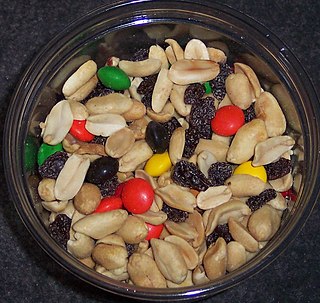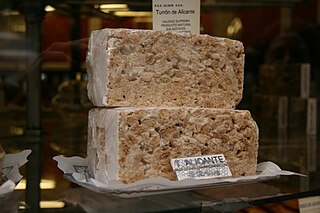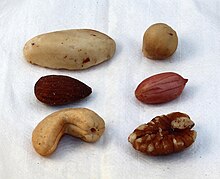
Trail mix or scroggin is a type of snack mix, typically a combination of granola, dried fruit, nuts, and sometimes candy, developed as a food to be taken along on hikes. Trail mix is considered a great snack food for hikes, because it is lightweight, easy to store, and nutritious, providing a quick energy boost from the carbohydrates in the dried fruit or granola, and sustained energy from fat in nuts.

Praline is a form of confection containing, at a minimum, culinary nuts – usually almonds, pecans and hazelnuts – and sugar. Cream is a common third ingredient.

A nut is a fruit consisting of a hard or tough nutshell protecting a kernel which is usually edible. In general usage and in a culinary sense, a wide variety of dry seeds are called nuts, but in a botanical context "nut" implies that the shell does not open to release the seed (indehiscent).

Pesto is a sauce that traditionally consists of crushed garlic, European pine nuts, coarse salt, basil leaves, and hard cheese such as Parmigiano-Reggiano or Pecorino Sardo, all blended with olive oil. It originated in Genoa, the capital city of Liguria, Italy.

Turrón, or torrone, is a Spanish nougat confection, typically made of honey, sugar, and egg white, with toasted almonds or other nuts, and usually shaped into either a rectangular tablet or a round cake. It is frequently consumed as a traditional Christmas dessert in Spain, Portugal, and Italy as well as countries formerly under the Spanish Empire and Portuguese Empire, particularly in Latin America.

Planters Nut & Chocolate Company is an American snack food company now owned by Hormel Foods. Planters is best known for its processed nuts and for the Mr. Peanut icon that symbolizes them. Mr. Peanut was created by grade schooler Antonio Gentile for a 1916 contest to design the company's brand icon. The design was modified by a commercial artist and has continued to change over the years.
Carrier oil, also known as base oil or vegetable oil, is used to dilute essential oils and absolutes before they are applied to the skin in massage and aromatherapy. They are so named because they carry the essential oil onto the skin. Diluting essential oils is a critical safety practice when using essential oils. Essential oils alone are volatile; they begin to dissipate as soon as they are applied. The rate of dispersion will vary based on how light or heavy the carrier oil is. Carrier oils do not contain a concentrated aroma, unlike essential oils, though some, such as olive, have a mild distinctive smell. Neither do they evaporate like essential oils, which are more volatile. The carrier oils used should be as natural and unadulterated as possible. Many people feel organic oils are of higher quality. Cold-pressing and maceration are the two main methods of producing carrier oils.

Beer Nuts is an American brand of snack food building on the original product, peanuts with a sweet-and-salty glazing. According to the manufacturer, the ingredients include peanuts, coconut oil, corn syrup and salt. In the United States, Beer Nuts are a staple of bar snacks and are often referred to as "the quintessential American bar food".

Chunky is a candy bar with milk chocolate, raisins, and roasted peanuts — using a sectioned and truncated pyramid shape. Chunky is produced by Ferrara Candy Company, a division of Ferrero SpA.

A nut butter is a spreadable foodstuff made by grinding nuts into a paste. The result has a high fat content and can be spread like true butter, but is otherwise unrelated. Nut butters include:

Crunchy Nut is a breakfast cereal made by Kellogg's with flakes of corn, honey, three types of sugar, and chopped peanuts. The product was created by Kellogg's employees at their Trafford Park factory in Greater Manchester and first introduced in 1980.

A tree nut allergy is a hypersensitivity to dietary substances from tree nuts and edible tree seeds causing an overreaction of the immune system which may lead to severe physical symptoms. Tree nuts include almonds, Brazil nuts, cashews, chestnuts, filberts/hazelnuts, macadamia nuts, pecans, pistachios, shea nuts and walnuts.

A nut roast or roasted nut loaf is a vegetarian dish consisting of nuts, grains, vegetable oils, broth or butter, and seasonings formed into a firm loaf shape or long casserole dish before roasting and often eaten as an alternative to a traditional British style roast dinner. It is popular with vegetarians at Christmas, as well as part of a traditional Sunday roast. Nut roasts are also made by Canadian and American vegetarians and vegans as the main dish for Thanksgiving or other harvest festival meals.

A candy bar is a type of candy that is in the shape of a bar. The most common type of candy bar is the chocolate bar, including both bars made of solid chocolate and combination candy bars, which are candy bars that combine chocolate with other ingredients, such as nuts, caramel, nougat, or wafers.

The Leavitt Corporation is a manufacturer of nuts and peanut butter, formed by Michael Hintlian in 1925. The company's manufacturing facility is located in Everett, Massachusetts, just north of Boston. Leavitt employs approximately 100 employees. The company is a third generation family-owned and operated company. Current owners consist of a living daughter and grandchildren of founder Michael Hintlian in addition to executive management. Leavitt's CEO currently is Mark Hintlian who succeeded his father James T. Hintlian in 2007. James (Jamie) T. Hintlian, Jr now serves as the company's chairman. Leavitt produces several products under three primary brand names: Teddie Peanut Butter, Americana and River Queen Nuts. Leavitt also produces nut butters and mixed nuts under a variety of private labels. Leavitt prides itself in strict adherence to food safety and quality standards and proudly holds a level III SQF food safety certification. Leavitt products are exported internationally to countries such as Switzerland, Serbia, Croatia, UK, Germany, Japan, Saudi Arabia, Russia, Brazil, Argentina and Panama.
Big D is a British brand of peanuts and other snack foods primarily sold in pubs. It was introduced in 1967. The brand includes 50g packets of nuts, both carded and tumble. They are distributed within the licensed and retail trade in the UK, and also in Ireland under an agreement with the Irish snack food manufacturer Tayto. The brand's peanut varieties include salted, dry roasted, bird's eye chili and honey roasted. The brand also includes salted cashews and smoked almonds. A range of shelf keeping units are also provided for various occasions and channels of trade.

Elmhurst 1925 is a plant-based food and beverage company located in Elma, New York. The company manufactures and sells non-dairy, plant-based milks made from nuts, grains, and seeds. The first four nutmilks – almond, cashew, hazelnut, and walnut – debuted at Natural Products Expo West in March 2017. A number of additional products have launched since, including their line of unsweetened plant milks made with only two to three ingredients, award winning barista editions, dairy-free creamers, and single serve ready-to-drink options.


















